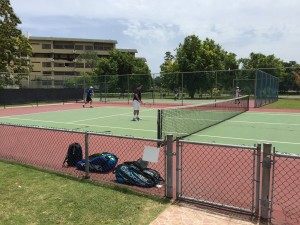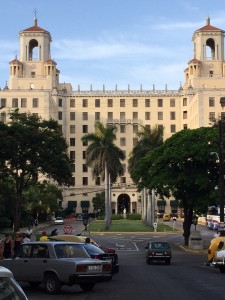By Evan Hendricks
Tennis anyone? Cuba anyone? This may come as a surprise, but those two questions combine for a yes-yes.
That’s right, and there are several options.
You can sign up for a group tennis tour at an exotic, far away beach resort. Or, you could venture to Varadero, Cuba’s most popular white-sand, turquois-water beach destination, and play at any one of several resort hotels offering courts and a resident pro.
And then there’s Havana, a can’t-miss for fans of the cosmopolitan, where you can find open tennis courts sprinkled throughout the city – if you know where to look. Plus, business travelers can seek out a local pro to take a lesson from – or hit with – for around $15 per hour.
Technically, Americans still can’t travel to Cuba as tourists. But if they can qualify for any of the 12 expansive categories established under the Obama Administration’s new rules (see below) from December 2014, they can start planning an excursion.
“I loved playing tennis in Cuba,” said Greg Schwarze, who went there as a teaching pro several consecutive years as part of a Canadian exchange program. He’s now the owner of the We Love Tennis store in Brampton, Ontario. “The people are very friendly, the scenery is awesome, there’s a lot of history, and the beaches, with the white sand and beautiful water, is a tropical paradise.”
(One caution: while many tennis courts in Cuba are playable, nearly every one of them is in need of a resurfacing.)
If you just want a purely tennis vacation at a beautiful beach resort, you might want to contact CanWorld, a Canadian-based travel agency with upcoming trips.
Amr Shagara, one of the Toronto-area pros who leads the trip, told World Tennis Magazine.com that in addition to a one-hour private lesson to work on stroke development and improvement, the 5-day trip includes morning drills and afternoon match play, game strategy, singles and doubles, built around a 4-hour break for lunch and ocean fun – at the Meliá Cayo Santa Maria Resort — East of Santa Clara city. Contact: Amr Shagara: amr@canworldtravel.com; (416) 732-3272; http://canworldtravel.com/cuba-tennis-trip/
Cuba’s best-known beach destination is Varadero, about 1 ½ hour drive from Havana. Varadero features more than 30 resorts, many of which have lighted tennis courts. Plus, most of them have rates which are “all-inclusive,” which covers three meals a day, drinks, laundry, live shows, and recreation. Of particular interest are the following resorts, where taking a lesson or hitting with the resident pro is also included (but caution, “included” doesn’t always mean “available” – you have to book it!)
Blue Diamond Resorts & Hotels, Canadian company, operates two resorts:
Memories Varadero Beach Resort (three tennis courts) &
Grand Memories Varadero (two courts)
http://www.bluediamondresorts.com/
Paradisus Varadero Resort & Spa (three courts, one lighted).
Contact: Lisandra Miranda Santana, Sale Executive
Tel. 53-45-66 8700 ext. 526; email: ventas1.pva@meliacuba.com;
web: www.paradisus-varadero.com
SuperClubs Breezes Resorts & Spas (four courts, one lighted).
Contact: Abe Moore, V.P. of Operations, Cuba.
Tel: 53 45 66 7030; email: Abe.Moore@superclubs.com
web: http://superclubscuba.com/en
Blau Varadero Hotel (two courts)
Contact: Zenia Hernández Mera, Entertainment Manager
email: entertainmentmanager@blauvaradero.tur.cu
Lourdes Gonzalez Ravelo, Sales Manager,
Tel: 53 45 66 7494; email: salesmanager@blauvaradero.tur.cu
Web: www.blau-hotels.com
Havana
You can’t truly say you’ve visited Cuba if you haven’t visited Havana. And you simply should not miss Havana if you are a fan of any of the following: Live music – jazz, salsa or traditional Cuban (like Buena Vista Social Club); baseball, ballet, 19th Century Architecture, 1950s American cars, Plazas, outdoor dining, or narrow streets in historic neighborhoods.
Although there are no official crime statistics to come by, Havana has a very low crime rate, and has a very “safe feel” to it.
Havana has a few options for travelers looking to play tennis.

The best hotel option is Hotel Memories Miramar (Occidental) Havana (also a Blue Diamond property). Located about a 15-minute taxi ride from Old Habana in Miramar residential district, the hotel feature four tennis courts – all of which will be lighted before the end of 2015. The locale hosted an ITF tournament at the end of June.
Joel Ponte, the Hotel’s tennis pro, will charge 10 Cuban pesos (“CUC” – $12 U.S.) per hour, for a lesson or a hitting session.
Contact: Camilo Seoane, Director of Recreation,
Hotel Memories Miramar
5TA. Ave. E/ 72 y 76, Playa –
Habana Cuba
Tel: (537) 204 8140 ext 831, 832
Email: jefe.animacion@memoriesmiramar.co.cu
Web: http://www.memoriesresorts.com/en/resort/havana.aspx
Across the way is the Hotel Meliá Habana, an impressive beach-front property with two courts, which have a nice view of the ocean, but could use some work. http://www.melia.com/en/hotels/cuba/havana/melia-habana/index.html
Competing with the Hotel Miramar for the best courts in Havana is the Residencial Club Havana a classic private club with four courts, a beach, massage, windsurfing, an Olympic pool, and restaurant. To use the club, an outsider would have to pay the monthly membership of 150 Cuban Pesos (“CUC” – $170 U.S.), which would give you full use of the facilities.
Contact: Betsy Padron Martinez
Phone: (537) 275-0366
Several tennis trainors work out of Club Havana, but also can free-lance elsewhere if they’re not already booked by existing clients. One of them is Favel Antonio Freyre Perdomo (call him “Fabel”), a former member of the Cuban Davis Cup team. Contact: Favel at (535) 358-5372; fabelantonio@nauta.cu
A low-budget option is the Kohly Hotel, which has a decent tennis court tucked away in the back, and a resident pro as well. www.hotelkohly.com/EN/hotel.html (address: Av. 49 Esquina 36 A Reparto Kohly Havana, Cuba)
Finally, if you want to hit on historic grounds, you can go to Havana’s grand dame and landmark, the Hotel Nacional. It has one tennis court (described as “fast as glass.”) The Hotel Nacional’s registry of historic events and famous people is too long to list. (www.hotelnacionaldecuba.com/en/history.asp)

Travel Tips for Americans:
[From the Huffington Post] If you’re wondering whether you qualify to travel to Cuba, here’s the list of acceptable categories of travel. For those without family ties to Cuba aiming to take advantage of the people-to-people category, the easiest way to ensure compliance is to use an agency experienced with organizing such trips.
Check the Treasury Department’s website for more info.
- Family visits.
- Official government business.
- Journalism.
- Professional research and meetings.
- Educational activities.
- Religious activities.
- Public performances, clinics, workshops, exhibitions and athletic competitions.
- “Support for the Cuban people.”
- Humanitarian projects.
- Activities of private foundations or research for educational institutes.
- Exporting or importing information or “information materials.”
- Travel related to some authorized export transactions.
FAQs: www.treasury.gov/resource-center/sanctions/Programs/Documents/cuba_faqs_new.pdf
Actual Rules: www.treasury.gov/resource-center/sanctions/Programs/Documents/31cfr515_new.pdf
Flying there: On July 10, 2015, JetBlue began a once-a-week non-stop Friday flight from New York’s John F. Kennedy International Airport to Havana. JetBlue operates four other charters flights to Cuba that depart from airports in Florida. Many of the seats are filled by Cuban natives returning to the country to visit family members, according to Philip Stewart, manager of corporate communications for JetBlue.
Air Canada offers daily non-stops to Toronto-Havana (6pm departure), with return flights departing daily at 8am.
Ferry Service: in May, President Obama approved ferry service from Florida to Cuba, a travel route that most likely will be implemented by the fall.
Currency: Bring U.S. dollars and change them at a major hotel, or a money changing house, known as a “Cadeca.” As of this writing, $100 U.S. = 87 Cuban Pesos (“CUC”). You CANNOT use U.S. Credit cards in Cuba, including TD Bank, which is now American-owned.
So, as of this writing, there’s no practical alternative to carrying cash.
Internet: Brace yourself: to use the Internet, you have to buy from your hotel an Internet card ranging from ($5 — $12), which only gets you one hour of connection, and ONLY in the hotel lobby (not even in your hotel room). Plus, sometimes the Internet is down and you can’t even get service in the lobby. Thus, it’s best to advise colleagues and family that you will only have sporadic access to email.
Telephone: Phone service works relatively well, once you know how to dial the numbers. But my hotel, for example, charged $2.50 per minute to call the U.S.
Food: Don’t be expecting any sort of “Foodie’s” paradise. The food is good and basic and locally grown. So chicken actually tastes like the chicken of my youth, etc.
Drinks: Hotels & Restaurants typically offer a full bar, along with wines from Spain and Chile. I only saw Cuban beer. You’ll also find Coke, Sprite & Fanta, along with the Cuban version of them.
People: The Cubans we met consistently were friendly, accessible, helpful, educated and proud of their country and heritage. The ones who learned English enjoyed the chance to practice. One traveler who arrived with the specific purpose of learning Spanish marveled at their patience and willingness to help, describing Cuba as a “country of teachers.”
Diego-Miles Hendricks contributed to this article. All photos courtesy of Diego-Miles Hendricks.
